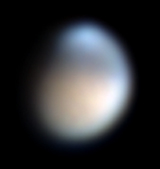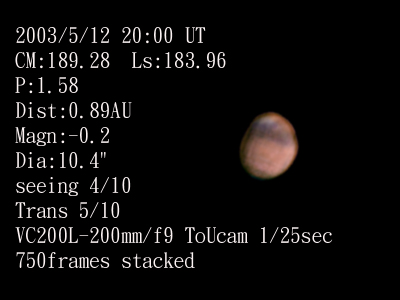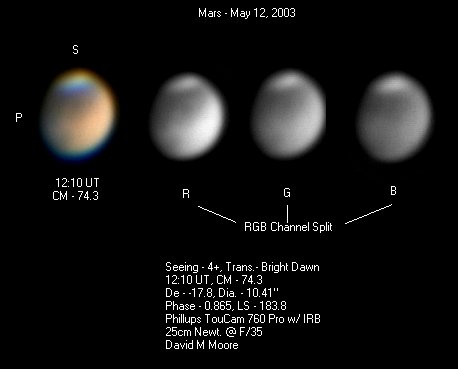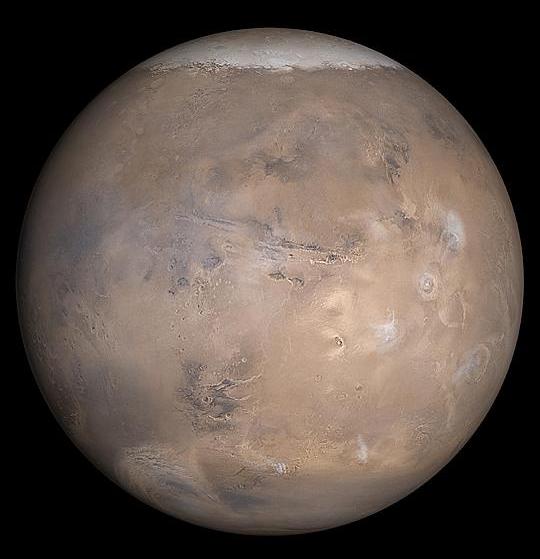火星 月惑星研究会 関西支部 (最新)
ALPO-Japan Latest
Mars Image 2003/05/12(UT)
根市満之,瀧本和彦,
Chen Hsun-Hsiao,David M Moore,Mars Global Surveyor
M.Neichi,K.Takimoto,Chen.H,D.Moore,MGS
解説(安達)
日本からはシレーン(Mare Sirenum;160W,-30)と、キンメリウム
(Mare Cimmerium;220W,-25)付近の観測と、なった。気流のよくない時
の観測であり、詳細は分からないが、トリビウム・カロンティス
(Trivium Charontis;200W,+20)付近がやや暗くなっていることが読み取
れる。北極地方がやや白っぽい雲に覆われていることと、西の端には
朝霧の出ていることが捉えられている。これは、瀧本氏の眼視観測で
も良く記録されている。チェン氏の画像ではアウソニア(Ausona;250W,
-40)付近がやや明るくなっているのが気になる。
ム−ア氏からはソリス(Solis lacus;90W,-25)付近の観測が送られて
きた。ソリス近辺は全体としてかなり暗くなっていることが、分かる。
(reported by 4 observers)
Mare Sirenum(160W,-30) and Mare Cimmerium (220W,-25)
were observed from Japan. Seeing was bad for Japan.
Trivium Charontis(200W,-25) can be seen in the dim. Fog comes
out at the end in the west. The North Pole seems covered with
light white cloud. This is recorded to the observation
of Mr.Takimoto. In the image of Chen, that Ausonia(250W,-40)
becomes bright becomes a feeling.
FROM Makoto ADACHI
-------------------------------------------------------------------------------------
|
Mitsuyuki Neichi (250mm Newtonian, SONY DV TRV900)
|
|

22003/05/12 19:10:10(UT)
Ls=183.94 CM=176.92
De=-18.27 Dia=10.43" P= 1.59
25cm F6ニュートン反射 Pentax XL 10.5mm コリメート
3degree Prizum
SONY DVカメラ TRV900 1/30秒 429frames composite
ウィナーフィルター、アンシャープマスク
Seeing 5/10
≪青森県三戸郡 根市満之≫
|
Kazuhiko takimoto (Drawing: 150mm Newtonian)
|
|
 ≪和歌山県東牟婁郡 瀧本和彦≫
≪和歌山県東牟婁郡 瀧本和彦≫
|
Chen Hsun-Hsiao ( 200mm VC200L Philips ToUcam Pro)
|
|
 [Chen Hsun-Hsiao : Kaohsiung Taiwan R.O.C]
≪チェン-スン-シァオ 台湾≫
[Chen Hsun-Hsiao : Kaohsiung Taiwan R.O.C]
≪チェン-スン-シァオ 台湾≫
|
David M. Moore(25cm Newtonian, Philips ToUcam)
|
|
This image is a bit late.
I over processed it slightly to enhance the evening hazes over Chryse.
Solis Lacus is prominent on the CM. Seeing conditions were not too bad,
but the overall quality of the image is a bit fuzzy.
 [ David M Moore Phoenix, Arizona U.S.A]
[ David M Moore Phoenix, Arizona U.S.A]
|
Mars Global Surveyor(Mars Orbiter Camera)
|
|

The Mars Global Surveyor (MGS) Mars Orbiter Camera (MOC) experiment consists of 3 different cameras: a narrow angle imager that provides the black-and-white high resolution views (up to 1.4 meters per pixel) of Mars, and 2 wide angle cameras, observing in red and blue wavelengths, from which color views of the entire planet are assembled each day. The wide angle cameras provide a daily record of changes in martian weather and surface frost as the seasons progress. MGS MOC has obtained a record of martian weather spanning a little over 2 martian years since it began systematic observations in March 1999.
The view of Mars shown here was assembled from MOC daily global images obtained on May 12, 2003. At that time, the northern hemisphere was in early autumn, and the southern hemisphere in early spring. At the left/center of this view are the four large Tharsis volcanoes: Olympus Mons, Ascraeus Mons, Pavonis Mons, and Arsia Mons. Stretching across the center of the globe is the ~5,000 kilometers (~3,000 miles) long Valles Marineris trough system. The seasonal south polar carbon dioxide frost cap is visible at the bottom of this view. A dust storm sweeps across the plains of northern Acidalia at the upper right. North is up, east is right, sunlight illuminates the planet from the left.
[ Mars Global Surveyor MASA]
 ALPO-Japan Latest
ALPO-Japan Latest

 Mars Section
Mars Section
 ≪和歌山県東牟婁郡 瀧本和彦≫
≪和歌山県東牟婁郡 瀧本和彦≫
≪和歌山県東牟婁郡 瀧本和彦≫
[Chen Hsun-Hsiao : Kaohsiung Taiwan R.O.C] ≪チェン-スン-シァオ 台湾≫
[ David M Moore Phoenix, Arizona U.S.A]

 ALPO-Japan Latest
ALPO-Japan Latest

 Mars Section
Mars Section